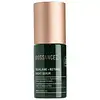What's inside
What's inside
 Key Ingredients
Key Ingredients

 Benefits
Benefits

 Concerns
Concerns

 Ingredients Side-by-side
Ingredients Side-by-side

Water
Skin ConditioningSqualane
EmollientGlycerin
HumectantCaprylic/Capric Triglyceride
MaskingCetearyl Olivate
Sorbitan Olivate
EmulsifyingRetinol
Skin ConditioningRetinal
Skin ConditioningAllantoin
Skin ConditioningCrocus Sativus Stigma Extract
Pseudozyma Epicola/Evening Primrose Oil Ferment Extract
EmollientTocopherol
AntioxidantRosmarinus Officinalis Leaf Extract
AntimicrobialOryza Sativa Bran Extract
Skin ConditioningCetearyl Alcohol
EmollientHelianthus Annuus Extract
EmollientHydroxyapatite
AbrasiveDextrin
AbsorbentCarbomer
Emulsion StabilisingSodium Gluconate
Skin ConditioningPhenoxyethanol
PreservativeEthylhexylglycerin
Skin ConditioningSodium Hydroxide
BufferingWater, Squalane, Glycerin, Caprylic/Capric Triglyceride, Cetearyl Olivate, Sorbitan Olivate, Retinol, Retinal, Allantoin, Crocus Sativus Stigma Extract, Pseudozyma Epicola/Evening Primrose Oil Ferment Extract, Tocopherol, Rosmarinus Officinalis Leaf Extract, Oryza Sativa Bran Extract, Cetearyl Alcohol, Helianthus Annuus Extract, Hydroxyapatite, Dextrin, Carbomer, Sodium Gluconate, Phenoxyethanol, Ethylhexylglycerin, Sodium Hydroxide
Water
Skin ConditioningIsobutane
Propane
Perfluorohexane
SolventDimethicone
EmollientPropanediol
SolventIsosorbide Dicaprylate
Skin ConditioningTrimethylolpropane Tricaprylate/Tricaprate
EmollientEchinacea Purpurea Extract
MoisturisingPerfluorodecalin
Skin ConditioningPerfluoroperhydrophenanthrene
Skin ConditioningTropaeolum Majus Flower/Leaf/Stem Extract
Skin ConditioningZanthoxylum Bungeanum Fruit Extract
Skin ConditioningSodium Hyaluronate
HumectantHydrolyzed Hyaluronic Acid
HumectantSodium Polyglutamate
HumectantPolyglutamic Acid
Skin ConditioningAdenosine
Skin ConditioningChondrus Crispus Extract
Skin ConditioningGlycine Soja Seed Extract
Skin ConditioningHydrolyzed Vegetable Protein
Skin ConditioningTrehalose
HumectantOleyl Alcohol
EmollientGlycerin
Humectant1,2-Hexanediol
Skin ConditioningBetaine
HumectantPolysilicone-11
Lavandula Angustifolia Flower Oil
MaskingCetearyl Alcohol
EmollientGlyceryl Stearate
EmollientSodium Lauroyl Glutamate
Stearic Acid
CleansingAcrylates/C10-30 Alkyl Acrylate Crosspolymer
Emulsion StabilisingLaureth-12
EmulsifyingCaprylhydroxamic Acid
Sodium Benzoate
MaskingPotassium Sorbate
PreservativeGluconolactone
Skin ConditioningEthylhexylglycerin
Skin ConditioningSodium Hydroxide
BufferingPhenoxyethanol
PreservativeLinalool
PerfumingWater, Isobutane, Propane, Perfluorohexane, Dimethicone, Propanediol, Isosorbide Dicaprylate, Trimethylolpropane Tricaprylate/Tricaprate, Echinacea Purpurea Extract, Perfluorodecalin, Perfluoroperhydrophenanthrene, Tropaeolum Majus Flower/Leaf/Stem Extract, Zanthoxylum Bungeanum Fruit Extract, Sodium Hyaluronate, Hydrolyzed Hyaluronic Acid, Sodium Polyglutamate, Polyglutamic Acid, Adenosine, Chondrus Crispus Extract, Glycine Soja Seed Extract, Hydrolyzed Vegetable Protein, Trehalose, Oleyl Alcohol, Glycerin, 1,2-Hexanediol, Betaine, Polysilicone-11, Lavandula Angustifolia Flower Oil, Cetearyl Alcohol, Glyceryl Stearate, Sodium Lauroyl Glutamate, Stearic Acid, Acrylates/C10-30 Alkyl Acrylate Crosspolymer, Laureth-12, Caprylhydroxamic Acid, Sodium Benzoate, Potassium Sorbate, Gluconolactone, Ethylhexylglycerin, Sodium Hydroxide, Phenoxyethanol, Linalool
 Reviews
Reviews

Alternatives
Ingredients Explained
These ingredients are found in both products.
Ingredients higher up in an ingredient list are typically present in a larger amount.
Cetearyl alcohol is a mixture of two fatty alcohols: cetyl alcohol and stearyl alcohol. It is mainly used as an emulsifier. Emulsifiers help prevent the separation of oils and products. Due to its composition, it can also be used to thicken a product or help create foam.
Cetearyl alcohol is an emollient. Emollients help soothe and hydrate the skin by trapping moisture.
Studies show Cetearyl alcohol is non-toxic and non-irritating. The FDA allows products labeled "alcohol-free" to have fatty alcohols.
This ingredient is usually derived from plant oils such as palm, vegetable, or coconut oils. There is debate on whether this ingredient will cause acne.
Due to the fatty acid base, this ingredient may not be Malassezia folliculitis safe.
Learn more about Cetearyl AlcoholEthylhexylglycerin (we can't pronounce this either) is commonly used as a preservative and skin softener. It is derived from glyceryl.
You might see Ethylhexylglycerin often paired with other preservatives such as phenoxyethanol. Ethylhexylglycerin has been found to increase the effectiveness of these other preservatives.
Glycerin is already naturally found in your skin. It helps moisturize and protect your skin.
A study from 2016 found glycerin to be more effective as a humectant than AHAs and hyaluronic acid.
As a humectant, it helps the skin stay hydrated by pulling moisture to your skin. The low molecular weight of glycerin allows it to pull moisture into the deeper layers of your skin.
Hydrated skin improves your skin barrier; Your skin barrier helps protect against irritants and bacteria.
Glycerin has also been found to have antimicrobial and antiviral properties. Due to these properties, glycerin is often used in wound and burn treatments.
In cosmetics, glycerin is usually derived from plants such as soybean or palm. However, it can also be sourced from animals, such as tallow or animal fat.
This ingredient is organic, colorless, odorless, and non-toxic.
Glycerin is the name for this ingredient in American English. British English uses Glycerol/Glycerine.
Learn more about GlycerinPhenoxyethanol is a preservative that has germicide, antimicrobial, and aromatic properties. Studies show that phenoxyethanol can prevent microbial growth. By itself, it has a scent that is similar to that of a rose.
It's often used in formulations along with Caprylyl Glycol to preserve the shelf life of products.
Sodium Hydroxide is also known as lye or caustic soda. It is used to adjust the pH of products; many ingredients require a specific pH to be effective.
In small amounts, sodium hydroxide is considered safe to use. However, large amounts may cause chemical burns due to its high alkaline.
Your skin has a natural pH and acid mantle. This acid mantle helps prevent harmful bacteria from breaking through. The acid mantle also helps keep your skin hydrated.
"Alkaline" refers to a high pH level. A low pH level would be considered acidic.
Learn more about Sodium HydroxideWater. It's the most common cosmetic ingredient of all. You'll usually see it at the top of ingredient lists, meaning that it makes up the largest part of the product.
So why is it so popular? Water most often acts as a solvent - this means that it helps dissolve other ingredients into the formulation.
You'll also recognize water as that liquid we all need to stay alive. If you see this, drink a glass of water. Stay hydrated!
Learn more about Water